New 1981-2010 Averages being used this year.
Note: This publication is currently undergoing major revisions. The current publication will be replaced with a new publication based on stakeholder requirements and scientific advances. We expect to begin sharing details on this soon. If you have input on content, format, or publication frequency at any time, please contact us at cbrfc.webmasters@noaa.gov.Upper Colorado Water Supply Outlook, May 1, 2012Upper Colorado Water Supply Outlook, May 1, 2012
Contents
Upper Colorado Summary
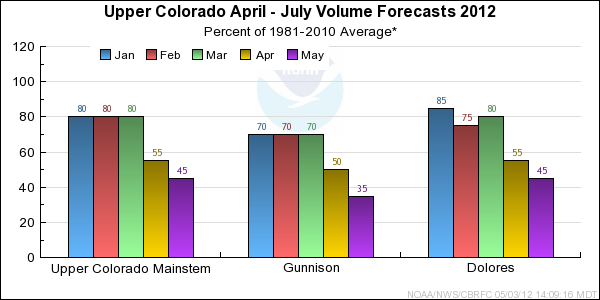
*Median of forecasts within each basin.
Upper Colorado Mainstem Basin Conditions
The following conditions influenced this month's forecasts:
Precipitation:
Seasonal October through April
precipitation
was near 65 percent of average in the Upper Colorado mainstem basin.
April was another much below average
precipitation
month with 50 percent of average.
Snow:
May 1st snow water equivalent was near just 20 percent of average in the basin as a whole.
In a normal year snow continues to accumulate through March and into the middle of April
at higher elevations, but this year snow melt began by the last half of March.
Most SNOTEL sites below 10,500 feet in the basin do not have any
snow left, and many of those melted out at the earliest time in their 30 year history.
--- Upper Colorado basin
snow
water equivalent plot
Streamflow:
April streamflow was near to above average in the basin as a whole. However,
some sites in the upper part of the basin had volumes greater than 150% of average.
Soil Moisture:
Modeled
soil
moisture states were above average heading into the winter.
Climate Forecasts:
La Nina climate conditions existed throughout the winter but these do not show a strong correlation with winter
precipitation in the Upper Colorado mainstem basin, and therefore were not influential in the development
of streamflow volume forecasts.
Forecast Summary:
A wet October was followed by much below average precipitation in November and December. Near average
precipitation occurred in January and February. March 2012 was one of the warmest and driest March's
in the last 30 years in the Upper Colorado basin and April was another warm, dry month, although not to
the same extent as March. As of May 1st the snow water equivalent was just 20 percent of average with
seasonal precipitation near 65 percent of average. There were again large drops in the
forecast runoff volumes from what was issued last month. Most of the May through July forecasts
are for volumes that would be the 2nd or 3rd lowest on record if they occurred.
Current May through July streamflow volume
forecasts
range between 25 and 50 percent of average with a median value of 40 percent.
Current April through July streamflow volume
forecasts
range between 35 and 55 percent of average with a median value of 45 percent.
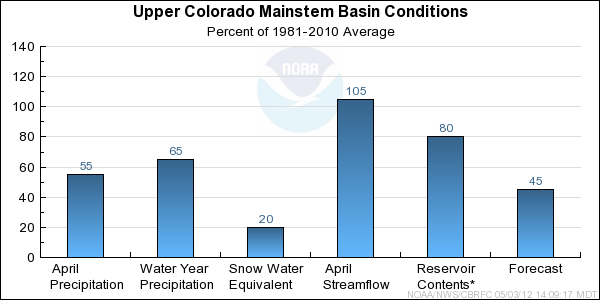
* Percent usable capacity, not percent average contents.
Click for multi-month Graph.
Gunnison Basin Conditions
The following conditions influenced this month's forecasts:
Precipitation:
Seasonal October through April
precipitation ranged from 60 to 85 percent of
average in most of the Gunnison River Basin.
April was another warm and dry month in the Gunnison Basin with
precipitation
generally between 30 to 65 percent of average.
Snow:
The May 1st snow water equivalent for the Gunnison Basin was near 30 percent of average. However snow has
melted out at several measuring sites. Where snow remains it ranged between 10 and 55 percent of average
on May 1st.
All areas have experienced a very early snow melt as above average
temperatures occurred in March and April. Some snow measuring sites that were void of snow in
April or early May melted out a full 4 to 6 weeks earlier than average.
Gunnison Basin
snow
water equivalent plot
Streamflow:
Streamflow volumes for April were near or above average, ranging from 100 to 145 percent of average
at higher elevation and headwater locations. At locations further downstream April streamflow ranged from
60 to 85 percent of average, most likely due to lack of snow that was depleted prior to April, and increased
irrigation demands due to the warm and dry conditions.
Soil Moisture:
Modeled
soil
moisture states were above average entering the winter season.
Climate Forecasts:
La Nina climate conditions existed throughout the winter but these do not show a strong
correlation with winter precipitation or Apri-July runoff volumes in the Gunnison Basin.
Therefore they were not influential in the development of streamflow volume forecasts.
Forecast Summary:
Although October was wet and soil moisture was above average entering the season,
the very dry and warm spring, lack of snow, and early snow melt have had a detrimental impact
on the anticpated April-July streamflow runoff volumes. Forecast runoff volumes have been further
reduced from those issued in April. Several forecasts are now the 2nd or 3rd lowest on record.
Seasonal April-July
streamflow runoff volumes
are expected to range from near 15 to 50 percent of average. May-July
streamflow runoff
volumes are expected to range from near 10 to 45 percent of average.
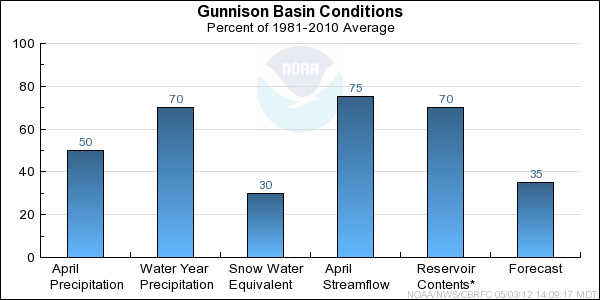
* Percent usable capacity, not percent average contents.
Click for multi-month Graph.
Dolores Basin Conditions
The following conditions influenced this month's forecasts:
Precipitation:
Seasonal October through April
precipitation ranged between 70 and
95 percent of average in the Dolores Basin.
April experienced above average temperatures and much below average
precipitation.
For individual sites April precipitation ranged from 20 to 80 percent of average, with a Basin
average of 60 percent.
Snow:
The May 1st snow water equivalent for the Dolores Basin was near 20 percent of average. However most
snow measring sites had already melted out with remaining snow confined to the highest elevations and
north facing or protected locations. Some snow measuring sites have melted out a full 4 to 8 weeks earlier
than average.
Dolores Basin
snow
water equivalent plot
Streamflow:
Streamflow volumes for April were near or above average at high elevation headwater locations, ranging from
105 to 150 percent of average. At locations further downstream April streamflow ranged from
55 to 90 percent of average, most likely due to lack of snow that was depleted prior to April, and increased
irrigation demands due to the warm and dry conditions.
Soil Moisture:
Modeled
soil
moisture states were near average entering the winter season.
Climate Forecasts:
La Nina climate conditions existed throughout the winter but these do not show a strong correlation
with winter precipitation or April-July runoff volumes in the Dolores Basin. Therefore,
it was not influential in the development of streamflow volume forecasts.
Forecast Summary:
Although October was wet and soil moisture was near or slightly above average entering the season,
the lack of snow during the winter combined with warmer and drier conditions during the spring
has had a detrimental impact on anticipated April-July streamflow runoff volumes. Forecast
runoff volumes have been further reduced from those issued in April. Some forecasts are now among
the bottom 5 on record. Forecast April-July
streamflow
runoff volumes are expected to range from 45 to 50 percent of the 1981-2000 average. May-July
streamflow runoff volumesrunoff volumes are expected to range between 30 and 40
percent of average.
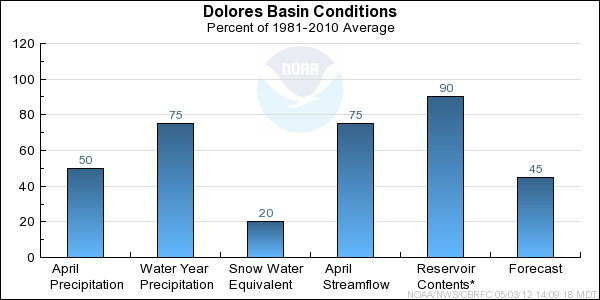
* Percent usable capacity, not percent average contents.
Click for multi-month Graph.
Differences between the full period forecasts and the residual forecasts may not exactly equal the actual observed volumes due to rounding conventions (see Definitions section).
Reservoir Monthly Inflow Forecasts
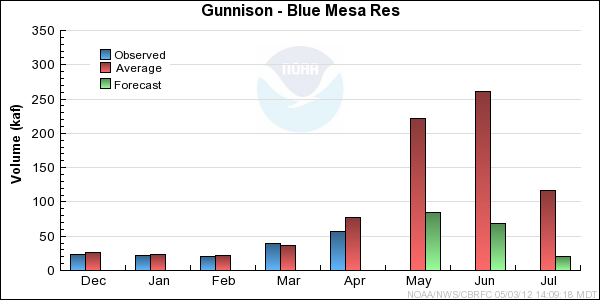
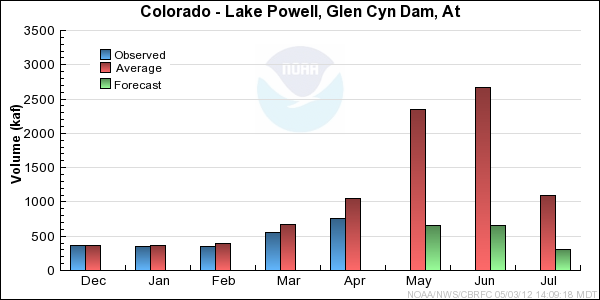
Monthly Streamflows
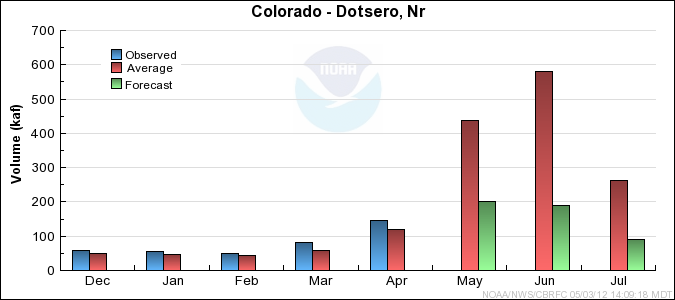
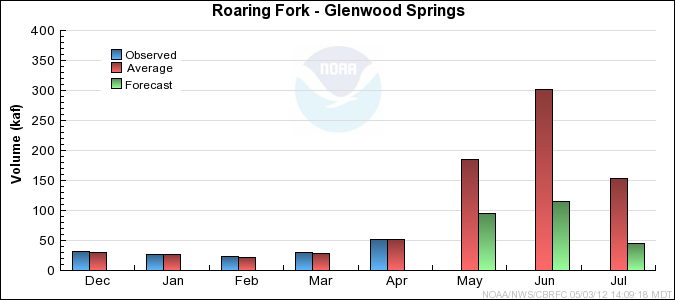
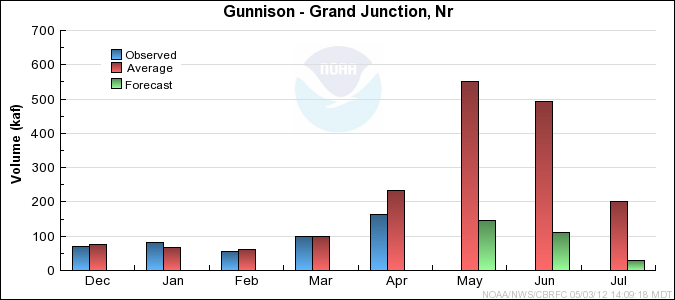
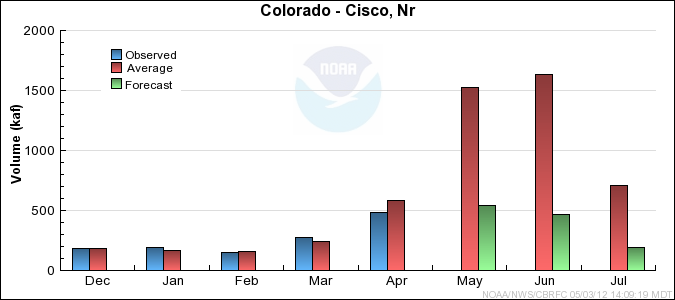
Precipitation Maps
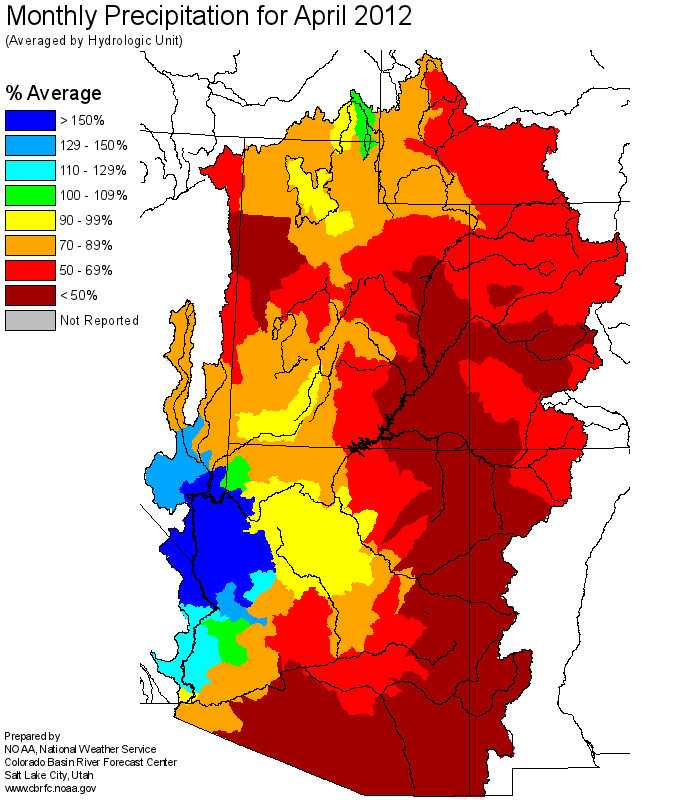
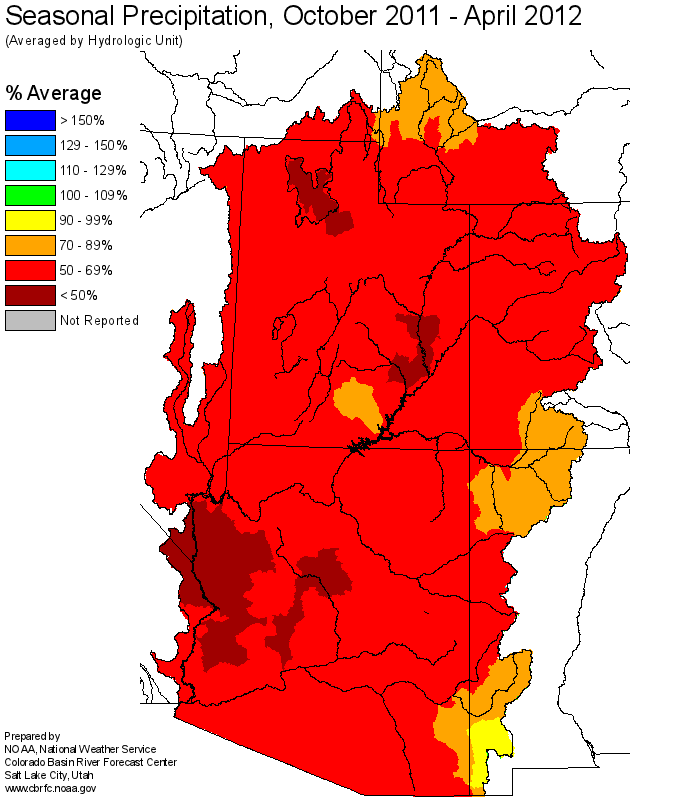
Hydrologist: Brenda Alcorn, Greg Smith













